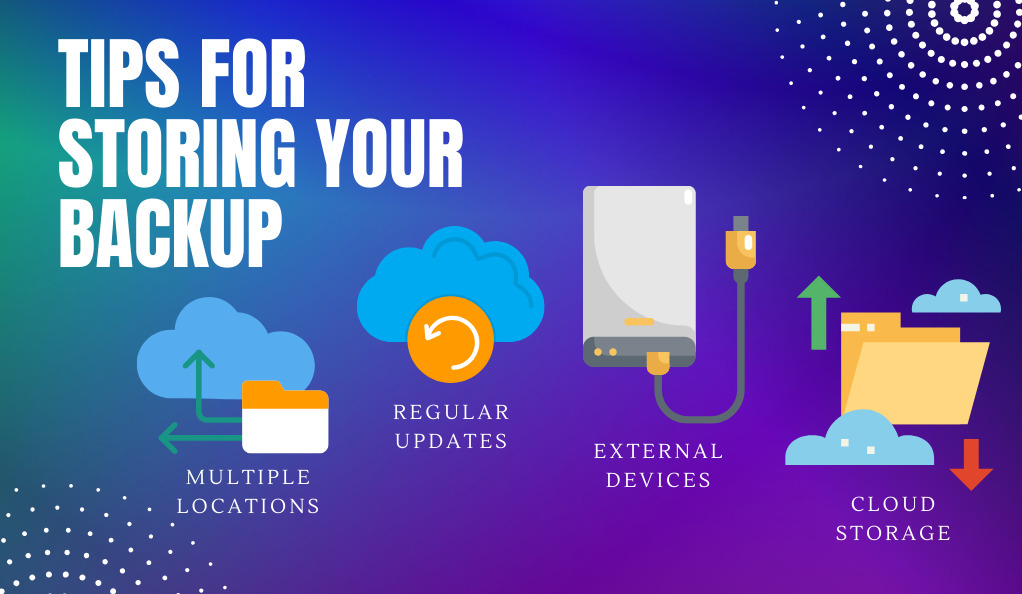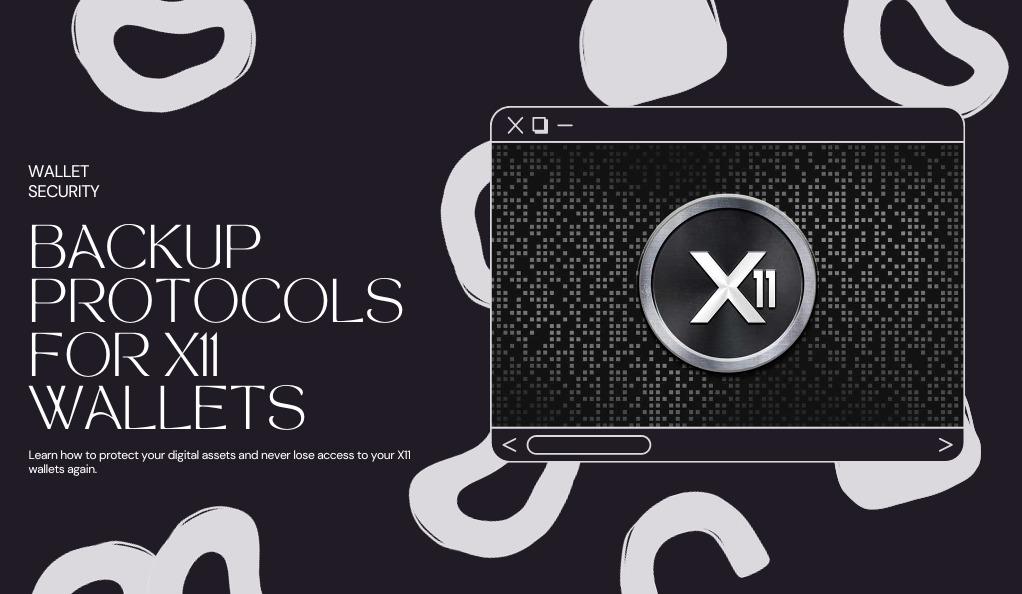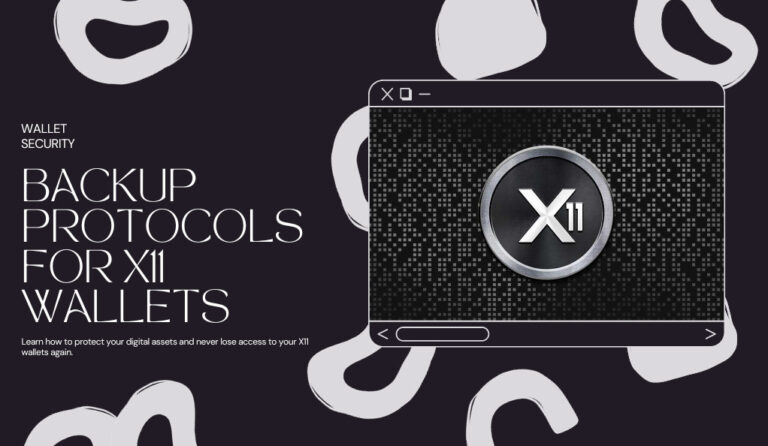In the ever-evolving world of cryptocurrencies, the X11 algorithm stands out as a significant innovation. Before diving deep into the backup protocols for X11 wallets, it’s crucial to understand what X11 is and why it’s so pivotal in the crypto landscape.
What is X11?
X11 is a chained hashing algorithm used by several cryptocurrencies as a proof-of-work system. It was first introduced by Dash (formerly known as Darkcoin) to combat the monopolization of mining by ASIC hardware. The “11” in X11 signifies the use of 11 different cryptographic algorithms chained together. This not only enhances security but also makes it more resistant to ASIC mining, ensuring a more decentralized and fair distribution of coins.

The Rise of X11 Wallets
With the introduction of the X11 algorithm, there was a surge in the popularity of X11-based cryptocurrencies. This led to the development of specialized wallets to store, manage, and transact these digital assets. An X11 wallet, like any other cryptocurrency wallet, is a digital tool that allows users to store their private keys and manage their crypto holdings. Given the digital nature of cryptocurrencies, these wallets become the primary target for potential hackers and cyber threats.
Why Secure Your Digital Assets?
The decentralized nature of cryptocurrencies means that there’s no central authority or bank to oversee or manage your assets. While this offers unparalleled freedom, it also comes with the responsibility of ensuring the security of your holdings. Imagine losing access to your wallet, and with it, all your digital assets. The consequences can be devastating, both financially and emotionally. Hence, securing and backing up your X11 wallet becomes paramount.
Understanding the Wallet.dat File
As we delve deeper into the world of X11 wallets, it’s essential to grasp the significance of the wallet.dat file. This file is the linchpin of your digital assets, holding the keys to your cryptocurrency kingdom.

The Essence of wallet.dat
The wallet.dat file is a digital file that resides within the core of your X11 wallet. It’s not just any regular file; it contains pairs of private and public cryptographic keys. These keys are the essence of your transactions on the blockchain. The private key is your unique identifier, allowing you to send and manage your cryptocurrency, while the public key is what others use to send cryptocurrency to you.
Why is wallet.dat So Crucial?
Imagine the wallet.dat file as the digital equivalent of a bank account passbook. Just as losing your passbook might prevent you from accessing your bank account, losing the wallet.dat file can permanently lock you out of your digital assets. Moreover, if someone else gets unauthorized access to this file and if it’s not encrypted, they can easily transfer all your assets to their own account.
Risks Associated with Compromising the wallet.dat File
- Unauthorized Access: If your
wallet.datfile falls into the wrong hands and isn’t encrypted, malicious actors can transfer your assets. - Loss of Access: If you lose this file and don’t have a backup, you lose access to all your assets stored in the wallet.
- Corruption: Like any digital file,
wallet.datis susceptible to corruption. If it gets corrupted and you lack a backup, you might lose access to your assets.
The Need for Encryption
Given the risks associated with the wallet.dat file, it’s evident why encryption is paramount. Encrypting this file ensures that even if someone gains unauthorized access, they won’t be able to make heads or tails of the data without the decryption key. In the context of X11 wallets, encryption isn’t just a best practice; it’s a necessity.
The Importance of Encryption
In the digital age, where cyber threats are rampant, encryption stands as the first line of defense for your precious digital assets. Let’s delve into why encryption is non-negotiable for X11 wallets and how it acts as a protective shield for your wallet.dat file.
What is Encryption?
At its core, encryption is the process of converting information into a code to prevent unauthorized access. When applied to the wallet.dat file, it ensures that the critical data within—your private and public keys—are unreadable without the correct decryption key or password.
Why Encrypt Your X11 Wallet?
- Security Against Theft: If someone gains unauthorized access to your computer or storage device, an encrypted
wallet.datfile remains a jumble of incomprehensible data without the correct password. - Protection from Malware: Certain malware types specifically target cryptocurrency wallets. Encryption acts as an additional layer of defense, making it harder for malware to access your funds.
- Peace of Mind: Knowing that your digital assets have an added layer of protection provides peace of mind, especially if you hold a significant amount in your wallet.
Steps to Encrypt Your X11 Wallet in Dash Core
- Open Dash Core: Launch the Dash Core application on your computer.
- Navigate to Settings: On the top menu, you’ll find the ‘Settings’ option. Click on it.
- Choose ‘Encrypt Wallet’: From the dropdown menu, select the ‘Encrypt Wallet’ option.
- Set a Strong Password: You’ll be prompted to enter a password. Ensure it’s strong, combining uppercase and lowercase letters, numbers, and symbols. Remember, this password is the key to your digital treasure, so never lose it.
- Confirmation: Once set, the application will seek confirmation. Upon confirming, Dash Core will close to complete the encryption process.
- Restart Dash Core: Relaunch the application. You’ll notice a lock icon at the bottom right, indicating that your wallet is now encrypted.
Regularly Update Your Encryption
Just as you’d change the locks on your doors periodically for security, it’s a good practice to change your encryption password now and then. This ensures that even if someone had a hint of your previous password, they’re kept at bay.
Backup from Dash Core: Step-by-Step
Having encrypted your X11 wallet, the next crucial step is to create a backup. A backup ensures that even if your primary device fails or you encounter unforeseen issues, you can still access your digital assets. Here’s a comprehensive guide on how to backup your X11 wallet using the Dash Core interface.
Why Backup is Non-Negotiable
Before diving into the steps, it’s essential to understand the gravity of having a backup:
- Device Failures: Computers and storage devices can fail. Whether it’s due to hardware issues, software corruption, or other technical problems, without a backup, you risk losing access to your assets.
- Human Errors: Accidental deletions or modifications can happen. A backup ensures that even if you mistakenly alter or remove your
wallet.datfile, you have a fallback. - Security Threats: In the event of a cyber-attack or malware infection, having a backup can be the difference between retaining or losing your digital assets.
Backing Up Using Dash Core
- Launch Dash Core: Start the Dash Core application on your device.
- Access the File Menu: On the top-left corner, click on the ‘File’ option.
- Select ‘Backup Wallet’: From the dropdown, choose the ‘Backup Wallet’ option.
- Choose Backup Location: A dialog box will appear prompting you to select where you’d like to save the backup. It’s advisable to save it on an external device, like a USB stick or an external hard drive.
- Name Your Backup: Provide a descriptive name for your backup file, such as “DashCore_Backup_DD_MM_YYYY,” replacing DD_MM_YYYY with the current date.
- Save: Click on the ‘Save’ button to initiate the backup process.
Tips for Storing Your Backup
- Multiple Locations: Always have more than one backup stored in different physical locations. This ensures that if one backup is compromised, you have others to rely on.
- Regular Updates: Periodically update your backups, especially after making significant transactions or changes.
- External Devices: Consider using devices that can be disconnected from the internet, like USB sticks or external hard drives. This minimizes the risk of online threats.
- Cloud Storage: While storing on cloud platforms like Google Drive or Dropbox offers accessibility, ensure the backup file is encrypted and the cloud account has two-factor authentication.

Alternative Backup Methods
While the Dash Core interface provides a straightforward way to backup your X11 wallet, it’s prudent to be aware of alternative methods. Diversifying your backup strategies ensures that you have multiple recovery options at your disposal, further bolstering the security of your digital assets.
1. Manual Backup of the wallet.dat File
Sometimes, the old-fashioned way is the most reliable:
- Ensure Dash Core is Closed: Before proceeding, make sure the Dash Core application is not running.
- Locate the wallet.dat File: Navigate to the DashCore data folder on your device. The default locations are:
- Windows:
C:\Users\YourUserName\AppData\Roaming\DashCore - Linux:
/home/YourUserName/.dashcore - macOS:
/Users/YourUserName/Library/Application Support/DashCore
- Windows:
- Copy the File: Once you locate the
wallet.datfile, copy it (do not cut or move). - Store in a Safe Location: Paste the copied file onto an external device or a secure cloud storage platform. Remember to encrypt the file if storing online.
2. Automatic Backups with Dash Core
Dash Core has a built-in feature that automatically creates backups of your wallet.dat file:
- Access Automatic Backups: Every time you launch Dash Core, it creates a backup in the
dashcore/backupsfolder. - Limit of Backups: By default, Dash Core retains up to 10 backup versions. The oldest backup gets deleted as a new one is created.
- Customize Backup Frequency: You can adjust the number of backups retained by modifying the
-createwalletbackups=nparameter in the Dash Core settings, wherenis the number of backups you wish to keep.
3. Paper Wallets
A paper wallet is a physical document that contains your private and public keys. It offers an offline method to store your assets:
- Generate a Paper Wallet: Use a trusted online paper wallet generator specific to X11-based cryptocurrencies.
- Print and Store: Once generated, print the document. Ensure the printout is clear and legible.
- Safety Precautions: Store the paper wallet in a safe, dry place. Consider laminating it to protect against wear and tear.
4. Hardware Wallets
Hardware wallets are physical devices designed to securely store cryptocurrency keys:
- Purchase a Reputable Wallet: Opt for trusted brands like Ledger or Trezor.
- Setup and Transfer: Follow the device’s setup instructions and transfer your assets from Dash Core to the hardware wallet.
- Store Safely: Keep the hardware wallet in a secure location, away from extreme temperatures and moisture.
Storing Backups in Physically Separate Locations
The importance of diversifying the storage of your backups cannot be overstated. Just as investors diversify their portfolios to mitigate risks, cryptocurrency holders should spread out their backups to safeguard against unforeseen disasters.
Why Separate Locations Matter
- Natural Disasters: Events like fires, floods, or earthquakes can damage or destroy physical storage mediums. If all your backups are in one place, such an event could wipe them all out.
- Theft or Burglary: If someone breaks into your home or office, having backups in different locations ensures that not all copies are at risk.
- Device Failures: Electronic devices can malfunction. If you’ve stored backups on multiple devices and one fails, you have others to fall back on.
Strategies for Diversified Storage
- Home and Office: Keep one backup at home and another at your workplace. Ensure they’re both in secure locations, like a locked drawer or safe.
- Safety Deposit Box: Consider renting a safety deposit box at a bank. It’s a secure environment, protected from most natural and man-made disasters.
- Trusted Individuals: Give a backup to someone you trust, like a family member or close friend. Ensure they understand its importance and keep it safe.
- Geographical Diversification: If possible, store a backup in a different city or even country. This might sound extreme, but for substantial holdings, it’s a consideration.
- Digital Diversification: In addition to physical copies, consider secure cloud storage options. Encrypt the file and use platforms that offer two-factor authentication.
Restoring Your Wallet from a Backup
No matter how securely you store your backups, they serve no purpose if you don’t know how to restore them. Here’s a step-by-step guide to restoring your X11 wallet:
- Install Dash Core: If you’re setting up on a new device or after a system reset, install the Dash Core application.
- Locate the DashCore Data Folder: Navigate to the default DashCore data folder on your device (as mentioned in the previous sections).
- Rename Existing wallet.dat: If there’s an existing
wallet.datfile, rename it to something likewallet_old.dat. - Copy Backup File: Take your backup
wallet.datfile and copy it into the DashCore data folder. - Launch Dash Core: Start the Dash Core application. It should now access the data from your backup file.
- Verify Transactions: Once opened, check your transaction history and balance to ensure everything looks accurate.
Backup Storage Considerations
While we’ve delved into the importance of diversifying backup storage and the restoration process, it’s equally crucial to understand the nuances of backup storage itself. Proper storage ensures the longevity and accessibility of your backups.
1. Digital vs. Physical Storage
- Digital Storage: This includes cloud storage, hard drives, USB sticks, and other electronic devices. While they offer convenience and easy access, they’re susceptible to electronic failures, hacking, and malware.
- Physical Storage: Paper wallets and written notes fall under this category. They’re immune to digital threats but can degrade over time or get damaged by environmental factors.
2. Environmental Factors
- Temperature: Extreme temperatures, both hot and cold, can damage electronic storage devices. Always store devices in a cool, dry place.
- Moisture: Humidity and water can be detrimental to both paper and electronic backups. Consider using moisture-proof containers or bags.
- Light: Prolonged exposure to sunlight can fade ink on paper wallets, making them unreadable. Store them away from direct sunlight.
3. Backup Software
- Versioning: Some backup software solutions offer versioning, allowing you to access previous versions of your backup. This can be beneficial if a file gets corrupted or if you need to access data from a specific date.
- Encryption: Opt for software that provides encryption options, adding an extra layer of security to your backups.
- Automation: Automated backup solutions can be set to backup at specific intervals, ensuring your backup is always up-to-date.
4. Frequency of Backups
- Regular Intervals: For active traders or those who frequently transact, daily or weekly backups might be necessary.
- After Significant Transactions: If you’ve just moved a large amount of cryptocurrency, it’s a good practice to create a backup immediately after.
5. Labeling and Organization
- Descriptive Names: Label your backups descriptively, including dates and any other pertinent information.
- Storage Log: Maintain a log detailing where each backup is stored, its date, and any other relevant notes. This ensures you can quickly locate and access backups when needed.
Verifying Your Backups
The process doesn’t end once you’ve stored your backups. Periodically, it’s essential to verify that your backups are functional and can be restored.
- Test Restoration: Every few months, try restoring your wallet from a backup on a separate device or virtual machine. This ensures the backup is functional.
- Check Data Integrity: Ensure that the restored data matches your current wallet, especially in terms of transaction history and balances.
- Update Storage Mediums: Technology evolves, and storage mediums become obsolete. Periodically transfer backups to newer storage solutions to ensure accessibility in the future.
Conclusion
In the dynamic landscape of cryptocurrency, where the line between immense gains and sudden losses is razor-thin, the importance of safeguarding one’s digital assets cannot be overstated. Through this comprehensive guide, we’ve journeyed through the intricacies of X11 wallets, delved deep into the significance of the wallet.dat file, emphasized the paramountcy of encryption, and explored the multifaceted world of backups.
But beyond the technicalities and step-by-step processes, the core message remains clear: vigilance and proactive measures are the cornerstones of digital asset security. By implementing robust backup protocols, regularly verifying backups, and staying updated with the latest security practices, cryptocurrency enthusiasts can navigate this promising yet volatile domain with confidence and peace of mind.
As we stand on the cusp of a digital revolution, let’s move forward with the assurance that our digital treasures are not only well-invested but also well-protected. After all, in the world of cryptocurrency, knowledge and preparedness are the true currencies of security.
At axerunners.com, our goal is to furnish well-rounded and trustworthy information regarding cryptocurrency, finance, trading, and stocks. Nonetheless, we avoid providing financial advice and instead encourage users to conduct their own research and meticulous verification.
Read More











